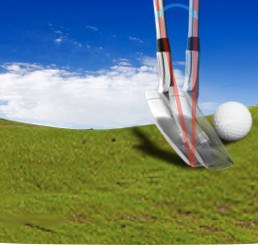
Golf Term: Turf
- Turf in golf refers to the grassy surface on which the game is played. It is an essential element of the golf course as it plays a significant role in the game.
- The quality and maintenance of the turf greatly influence the performance of the golfer and the overall playing experience.
- There are several types of turfs used in golf courses, including Bermuda grass, Bentgrass, Zoysia grass, and more. Each type has its own characteristics and requires specific care and maintenance.
Turf Characteristics:
- Density: The density of the turf affects how the ball interacts with the surface. A dense turf provides a better ball roll and a more consistent playing experience.
- Texture: Turf texture refers to the fineness or coarseness of the grass blades. Different textures can affect the golfer's ability to control the ball and make accurate shots.
- Firmness: The firmness of the turf is crucial in determining how the golf ball reacts when it lands. A firm turf allows for better ball control and reduces the chances of the ball bouncing or rolling too far upon impact.
- Consistency: Consistency of the turf ensures that all players face similar conditions throughout the golf course, providing a fair playing field.
Turf Maintenance:
- Mowing: Regular mowing is essential to maintain the desired height of the turf. The height of the grass can vary depending on the golf course, but it is typically kept short to enable a smooth roll of the golf ball.
- Watering: Proper irrigation is crucial to keep the turf healthy. Watering schedules should be planned to avoid over-saturation or dryness, as both can negatively impact the turf quality.
- Aeration: Aeration involves creating small holes in the turf to improve air circulation, enhance water penetration, and reduce soil compaction. This process helps the roots of the turf to grow deeper.
- Fertilization: Timely application of fertilizers provides essential nutrients to the grass, helping it to grow and remain healthy. Fertilization schedules can differ depending on various factors like weather conditions and grass type.
- Weed and Pest Control: Regular inspections and appropriate measures should be taken to control weed growth and prevent damage caused by pests or diseases.
Impact of Turf on Golfers:
- Turf quality can affect the golfer's ability to make consistent shots, especially when it comes to putting. Uneven or poorly maintained turfs can lead to unpredictable ball rolls and may require adjustments in the golfer's technique.
- Golfers need to adapt their strategies and club choices based on the turf conditions. For example, softer turfs may require more loft to prevent the ball from digging into the ground, whereas firmer turfs may allow for more aggressive shots.
- The challenge and beauty of golf lie in playing across various types of turfs, each providing a unique playing experience. Golfers must learn to adapt and improve their skills across different turfs to excel in the game.
Understanding the importance of turf in golf and its impact on gameplay can help golfers appreciate the efforts put into maintaining a high-quality golf course.





